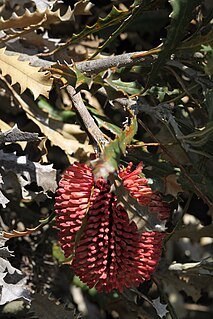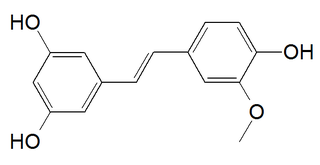
Gnetophyta is a division of plants, grouped within the gymnosperms, that consists of some 70 species across the three relict genera: Gnetum, Welwitschia, and Ephedra. Fossilized pollen attributed to a close relative of Ephedra has been dated as far back as the Early Cretaceous. Though diverse and dominant in the Paleogene and the Neogene, only three families, each containing a single genus, are still alive today. The primary difference between gnetophytes and other gymnosperms is the presence of vessel elements, a system of conduits that transport water within the plant, similar to those found in flowering plants. Because of this, gnetophytes were once thought to be the closest gymnosperm relatives to flowering plants, but more recent molecular studies have brought this hypothesis into question.

The gymnosperms, also known as Acrogymnospermae, are a group of seed-producing plants that includes conifers, cycads, Ginkgo, and gnetophytes. The term "gymnosperm" comes from the composite word in Greek: γυμνόσπερμος, literally meaning "naked seeds". The name is based on the unenclosed condition of their seeds. The non-encased condition of their seeds contrasts with the seeds and ovules of flowering plants (angiosperms), which are enclosed within an ovary. Gymnosperm seeds develop either on the surface of scales or leaves, which are often modified to form cones, or solitary as in yew, Torreya, Ginkgo.

Gnetum is a genus of gymnosperms, the sole genus in the family Gnetaceae and order Gnetales. They are tropical evergreen trees, shrubs and lianas. Unlike other gymnosperms, they possess vessel elements in the xylem. Some species have been proposed to have been the first plants to be insect-pollinated as their fossils occur in association with extinct pollinating scorpionflies. Molecular phylogenies based on nuclear and plastid sequences from most of the species indicate hybridization among some of the Southeast Asian species. Fossil-calibrated molecular-clocks suggest that the Gnetum lineages now found in Africa, South America and Southeast Asia are the result of ancient long-distance dispersal across seawater.

Gnetum gnemon is a species of Gnetum native to southeast Asia and the western Pacific Ocean islands, from Mizoram and Assam in India, south and east through Indonesia and Malaysia to the Philippines and Fiji. Common names include gnemon, melinjo, belinjo, kuliat/culiat, bago, bigo and padi oats or paddy oats.

Aiphanes is a genus of spiny palms which is native to tropical regions of South and Central America and the Caribbean. There are about 26 species in the genus, ranging in size from understorey shrubs with subterranean stems to subcanopy trees as tall as 20 metres (66 ft). Most have pinnately compound leaves ; one species has entire leaves. Stems, leaves and sometimes even the fruit are covered with spines. Plants flower repeatedly over the course of their lifespan and have separate male and female flowers, although these are borne together on the same inflorescence. Although records of pollinators are limited, most species appear to be pollinated by insects. The fruit are eaten by several birds and mammals, including at least two species of amazon parrots.

Luteolin is a flavone, a type of flavonoid, with a yellow crystalline appearance.

Double fertilization is a complex fertilization mechanism of flowering plants (angiosperms). This process involves the joining of a female gametophyte with two male gametes (sperm). It begins when a pollen grain adheres to the stigma of the carpel, the female reproductive structure of a flower. The pollen grain then takes in moisture and begins to germinate, forming a pollen tube that extends down toward the ovary through the style. The tip of the pollen tube then enters the ovary and penetrates through the micropyle opening in the ovule. The pollen tube proceeds to release the two sperm in the megagametophyte.

p-Coumaric acid is a hydroxycinnamic acid, an organic compound that is a hydroxy derivative of cinnamic acid. There are three isomers of coumaric acid—o-coumaric acid, m-coumaric acid, and p-coumaric acid—that differ by the position of the hydroxy substitution of the phenyl group. p-Coumaric acid is the most abundant isomer of the three in nature. p-Coumaric acid exists in two forms trans-p-coumaric acid and cis-p-coumaric acid.

Banksia aculeata, commonly known as prickly banksia, is a species of plant of the family Proteaceae native to the Stirling Range in the southwest of Western Australia. A shrub up to 2 m (7 ft) tall, it has dense foliage and leaves with very prickly serrated margins. Its unusual pinkish, pendent (hanging) flower spikes, known as inflorescences, are generally hidden in the foliage and appear during the early summer. Although it was collected by the naturalist James Drummond in the 1840s, Banksia aculeata was not formally described until 1981, by Alex George in his monograph of the genus.

Banksia caleyi, commonly known as the red lantern banksia or banksia, is a species of woody shrub of the family Proteaceae native to Western Australia. It generally grows as a dense shrub up to 2 m (7 ft) tall, has serrated leaves and red, pendent (hanging) inflorescences which are generally hidden in the foliage. First described by Scottish naturalist Robert Brown in 1830, Banksia caleyi was named in honour of the English botanist George Caley. No subspecies are recognised. It is one of three or four related species with hanging inflorescences, which is an unusual feature within the genus.

Pinosylvin is a pre-infectious stilbenoid toxin that is synthetized in plants during fungal infections, ozone induced stress and physical damage for example. It is a fungitoxin protecting the wood from fungal infection. It is present in the heartwood of Pinaceae and also found in Gnetum cleistostachyum.

Aiphanes horrida is a palm native to northern South America and Trinidad and Tobago. Aiphanes horrida is a solitary, spiny tree. In the wild it grows 3–10 metres tall tall with a stem diameter of 6–10 centimetres ; cultivated trees may be as much as 15 m (49') tall with a 15 cm (6") diameter. The epicarp and mesocarp of the fruit are rich in carotene and are eaten in Colombia, while the seeds are used to make candles. In parts of the Colombian Llanos endocarps are used to play games.

Aiphanes minima is a spiny palm tree which is native to the insular Caribbean from Hispaniola to Grenada, and widely cultivated elsewhere. Usually 5–8 metres (16–26 ft) tall, it sometimes grows as an understorey tree and only 2 m (6.6 ft) in height.

Piceatannol is a stilbenoid, a type of phenolic compound.

Gnetum africanum is a vine gymnosperm species found natively throughout tropical Africa. Though bearing leaves, the genus Gnetum are gymnosperms, related to pine and other conifers.

The spermatophytes, also known as phanerogams or phaenogams, comprise those plants that produce seeds, hence the alternative name seed plants. They are a subset of the embryophytes or land plants. The term phanerogams or phanerogamae is derived from the Greek φανερός, phanerós meaning "visible", in contrast to the cryptogamae from Greek κρυπτός kryptós = "hidden" together with the suffix γαμέω, gameo, "to marry". These terms distinguished those plants with hidden sexual organs (cryptogamae) from those with visible sexual organs (phanerogamae).

Rhapontigenin is a stilbenoid. It can be isolated from Vitis coignetiae or from Gnetum cleistostachyum.

Isorhapontigenin is a tetrahydroxylated stilbenoid with a methoxy group. It is an isomer of rhapontigenin and an analog of resveratrol. It is found in the Chinese herb Gnetum cleistostachyum, in Gnetum parvifolium and in the seeds of the palm Aiphanes aculeata.
Gnetum cleistostachyum is a liana species in the Sessiles subsection of the genus Gnetum described from South East Yunnan.

Gnetucleistol D is a stilbenoid found in the Chinese herb Gnetum cleistostachyum.


















